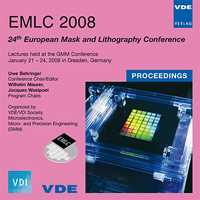Phase-shifting photomask repair and repair validation procedure for transparent & opaque defects relevant for the 45nm node and beyond
Conference: EMLC 2008 - 24th European Mask and Lithography Conference
01/21/2008 - 01/24/2008 at Dresden, Germany
Proceedings: EMLC 2008
Pages: 8Language: englishTyp: PDF
Personal VDE Members are entitled to a 10% discount on this title
Authors:
Ehrlich, Christian; Buttgereit, Ute; Boehm, Klaus; Scheruebl, Thomas (Carl Zeiss SMS GmbH, Carl Zeiss Promenade 10, 07745 Jena, Germany)
Edinger, Klaus; Bret, Tristan (Nawotec GmbH – a Carl Zeiss SMS GmbH company)
Abstract:
With the continuing decrease of feature sizes on photomasks and the related rising costs for current and future masks the importance of a reliable repair and repair assessment process has often been highlighted. The assessment, repair and repair validation of these expensive masks has become a very substantial factor of the total mask production cost The introduction of immersion lithography and the proposed introduction of double exposure strategies will further amplify this trend. In this paper we have concentrated on masks with feature sizes relevant for the 45nm node and defects with typical size and shape as they appear in production. Phase shifting masks with synthetic defects have been manufactured and the printability of the defects is analyzed with an AIMSTM45-193i. For representative defects the outline and three-dimensional shape as well as further characteristics have been visualized with the inherent electron microscope capability of the electron beam based repair tool, prior to repairing them with the repair system. In addition we will show the behaviour of the phase of the mask in a region of interest, that is in this case the repair area and its immediate vicinity. This will be done by a special new tool, named Phame(R), developed for measuring the actual phase of smallest mask features with a high spatial resolution.


